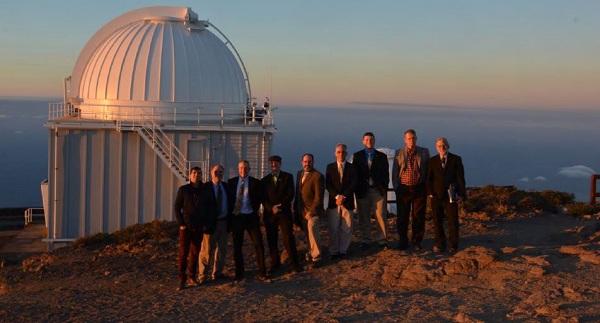Newly Acquired Telescope Gives Embry-Riddle and Partner Institutions Unique Opportunity to Collaborate on Research in Canary Islands

A joint international effort including Embry-Riddle Aeronautical University recently transformed a decommissioned telescope in the Canary Islands off the coast of Northern Africa into a remotely accessible instrument for research, education and outreach. An agreement between the Southeastern Association for Research in Astronomy (SARA) and the Instituto de Astrofisica de Canarias (IAC) outlines how the groups will jointly operate the telescope, which has been inactive for a decade, after upgrades funded by a $500,000 grant from the U.S. National Science Foundation.
Led by Embry-Riddle, SARA is a consortium of colleges and universities in the United States that includes Florida Institute of Technology, East Tennessee State University, Valdosta State University, Florida International University, Clemson University, Ball State University, Agnes Scott College, University of Alabama, Valparaiso University, Butler University, Texas A&M Commerce, Embry-Riddle Aeronautical University and now the Instituto de Astrofisica de Canarias.
Dr. Terry Oswalt, SARA Chairman, hosted the commissioning ceremony for SARA on the Spanish island of La Palma in the Canary Islands, along with members of the SARA Board of Directors, Dr. Rafael Rebolo, Director of the IAC, local authorities and scientists related to the project.
“The commissioning of the SARA-JKT telescope represents a major milestone in the 25-year history of the SARA consortium,” said Oswalt, who is also Chair of the Physical Sciences Department at Embry-Riddle’s Daytona Beach Campus in Florida. “The telescope is better than new and will be accessible from anywhere in the world with an Internet connection. We are especially excited about this new international partnership with the IAC and look forward to many years of scientific collaboration involving faculty, staff and students at all our partner institutions.”
The 1-meter Jacobus Kapteyn Telescope (JKT) was originally constructed by the United Kingdom, Ireland and the Netherlands more than 30 years ago as part of the Roque de los Muchachos Observatory to take advantage of the excellent atmospheric conditions afforded by this high-altitude volcanic island. It was decommissioned in 2003. In 2012 it was transferred to the IAC, and in 2014 an operating agreement for the telescope was reached between SARA and the IAC.
“The addition of the JKT to the network of telescopes operated by SARA allows an extraordinary temporal coverage in the Northern Hemisphere,” said Rebolo during the dedication. “Adding a telescope in the Southern Hemisphere will help us all to do better science.”
IAC staff will have access to time on the JKT as well as setting up collaborative projects with other SARA scientists using the other consortium telescopes, located at Kitt Peak in Arizona and Cerro Tololo in Chile.
Since 1995, SARA has operated a 1-meter telescope at Kitt Peak National Observatory under an agreement with the U.S. National Science Foundation (NSF). The SARA 0.6-meter telescope at Cerro Tololo has been operated in partnership with the NSF, the Chilean astronomical community and Lowell Observatory since 2010. SARA astronomers have been using these facilities to pursue research ranging from asteroids to quasars; they are also used by students in the classroom and for public outreach events.
Thousands of miles separate the three SARA telescopes. “Just as having two eyes gives depth perception, the SARA telescopes give us the ability to quickly measure distances and orbits for objects like potentially hazardous asteroids,” said Oswalt. “Because they are at different longitudes, we can stay focused on an object longer and we have a hedge against inclement weather at any given site. That’s hugely important to the study of objects that vary in brightness, such as pulsating stars like white dwarfs or transiting exoplanets.” Oswalt’s main area of study is white dwarf stars, the dense small cores of dead stars that no longer burn hydrogen.
Learn more about the Southeastern Association for Research in Astronomy at saraobservatory.org.

 James Roddey
James Roddey